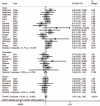Vitamin D Receptor Gene FokI Polymorphism Contributes to Increasing the Risk of Tuberculosis: An Update Meta-Analysis
- PMID: 26705207
- PMCID: PMC4697973
- DOI: 10.1097/MD.0000000000002256
Vitamin D Receptor Gene FokI Polymorphism Contributes to Increasing the Risk of Tuberculosis: An Update Meta-Analysis
Abstract
The association between vitamin D receptor (VDR) FokI polymorphism and tuberculosis (TB) risk remains a matter of debate. Potential selection bias exists in most studies using HIV-positive TB patients.An update meta-analysis was carried out to derive a more reliable assessment of the association between FokI polymorphisms and TB risk, especially in HIV-negative TB patients. All major databases from inception to June 2015 were searched for all publications that studied the association between FokI polymorphism and TB risk. The odds ratios (ORs) and the corresponding 95% confidence intervals (CIs) were calculated according to the frequencies of genotypes.In total, 32 studies with 4894 cases and 5319 controls were included in this meta-analysis. In the overall analysis, the estimated OR was 1.34 (95% CI=1.091-1.646, P = 0.005) in the best genetic model (recessive model, ff vs fF+FF) with moderate heterogeneity (I = 32.2%, P = 0.043). In the subgroup analysis stratified by HIV status, significant associations were found only in the HIV-negative TB group (OR = 1.60, 95% CI = 1.180-2.077, P = 0.002; I = 29.5%, and P = 0.141 for heterogeneity). In the subgroup analysis stratified by ethnicity, significant associations were found in the Asian group (OR = 1.65, 95% CI = 1.205-2.261, P = 0.002; I = 43.9%, and P = 0.024 for heterogeneity), but not in the Caucasian group (OR = 1.09, 95% CI = 0.762-1.547, P = 0.649; I = 0.0%, and P = 0.740 for heterogeneity) and African group (OR = 0.99, 95% CI = 0.726-1.341, P = 0.934; I = 43.9%, and P = 0.024 for heterogeneity).This meta-analysis confirms that VDR FokI polymorphism contributes to the risk of TB, especially in HIV-negative TB patients and in the Asian group. Further studies are required to clarify the role of the FokI polymorphism in HIV-positive TB and in other ethnic groups.
Conflict of interest statement
The authors have no funding and conflicts of interest to disclose.
Figures





Similar articles
-
Vitamin D Receptor Gene FOKI Polymorphism Contributes to Increasing the Risk of HIV-Negative Tuberculosis: Evidence from a Meta-Analysis.PLoS One. 2015 Oct 20;10(10):e0140634. doi: 10.1371/journal.pone.0140634. eCollection 2015. PLoS One. 2015. PMID: 26485279 Free PMC article.
-
Vitamin D receptor FokI gene polymorphism and tuberculosis susceptibility: a meta-analysis.Genet Mol Res. 2015 Jun 11;14(2):6156-63. doi: 10.4238/2015.June.9.1. Genet Mol Res. 2015. PMID: 26125816
-
Vitamin D receptor genetic polymorphisms and tuberculosis among Chinese Han ethnic group.Chin Med J (Engl). 2012 Mar;125(5):920-5. Chin Med J (Engl). 2012. PMID: 22490597
-
FokI polymorphism of the vitamin D receptor (VDR) gene and susceptibility to tuberculosis: Evidence through a meta-analysis.Infect Genet Evol. 2021 Aug;92:104871. doi: 10.1016/j.meegid.2021.104871. Epub 2021 Apr 24. Infect Genet Evol. 2021. PMID: 33901685
-
Vitamin D receptor gene FokI polymorphisms and tuberculosis susceptibility: a meta-analysis.Arch Med Sci. 2016 Oct 1;12(5):1118-1134. doi: 10.5114/aoms.2016.60092. Epub 2016 May 20. Arch Med Sci. 2016. PMID: 27695504 Free PMC article. Review.
Cited by
-
The association between polymorphisms in the PDCD1 gene and the risk of cancer: A PRISMA-compliant meta-analysis.Medicine (Baltimore). 2016 Oct;95(40):e4423. doi: 10.1097/MD.0000000000004423. Medicine (Baltimore). 2016. PMID: 27749524 Free PMC article. Review.
-
Association of VDR gene polymorphisms and 22 bp deletions in the promoter region of TLR2Δ22 (-196-174) with increased risk of pulmonary tuberculosis: A case-control study in tea garden communities of Assam.J Clin Lab Anal. 2018 Sep;32(7):e22562. doi: 10.1002/jcla.22562. Epub 2018 May 4. J Clin Lab Anal. 2018. PMID: 29727015 Free PMC article.
-
Allelic-Specific Regulation of xCT Expression Increases Susceptibility to Tuberculosis by Modulating microRNA-mRNA Interactions.mSphere. 2020 Apr 22;5(2):e00263-20. doi: 10.1128/mSphere.00263-20. mSphere. 2020. PMID: 32321821 Free PMC article.
-
Hepatitis B virus downregulates vitamin D receptor levels in hepatoma cell lines, thereby preventing vitamin D-dependent inhibition of viral transcription and production.Mol Med. 2018 Oct 16;24(1):53. doi: 10.1186/s10020-018-0055-0. Mol Med. 2018. PMID: 30326825 Free PMC article.
-
Influence of Genetic Polymorphism Towards Pulmonary Tuberculosis Susceptibility.Front Med (Lausanne). 2018 Aug 16;5:213. doi: 10.3389/fmed.2018.00213. eCollection 2018. Front Med (Lausanne). 2018. PMID: 30167433 Free PMC article. Review.
References
Publication types
MeSH terms
Substances
LinkOut - more resources
Full Text Sources
Medical

